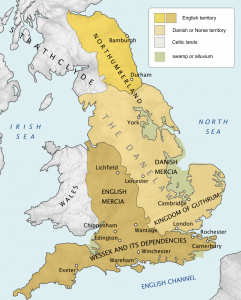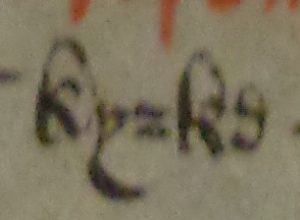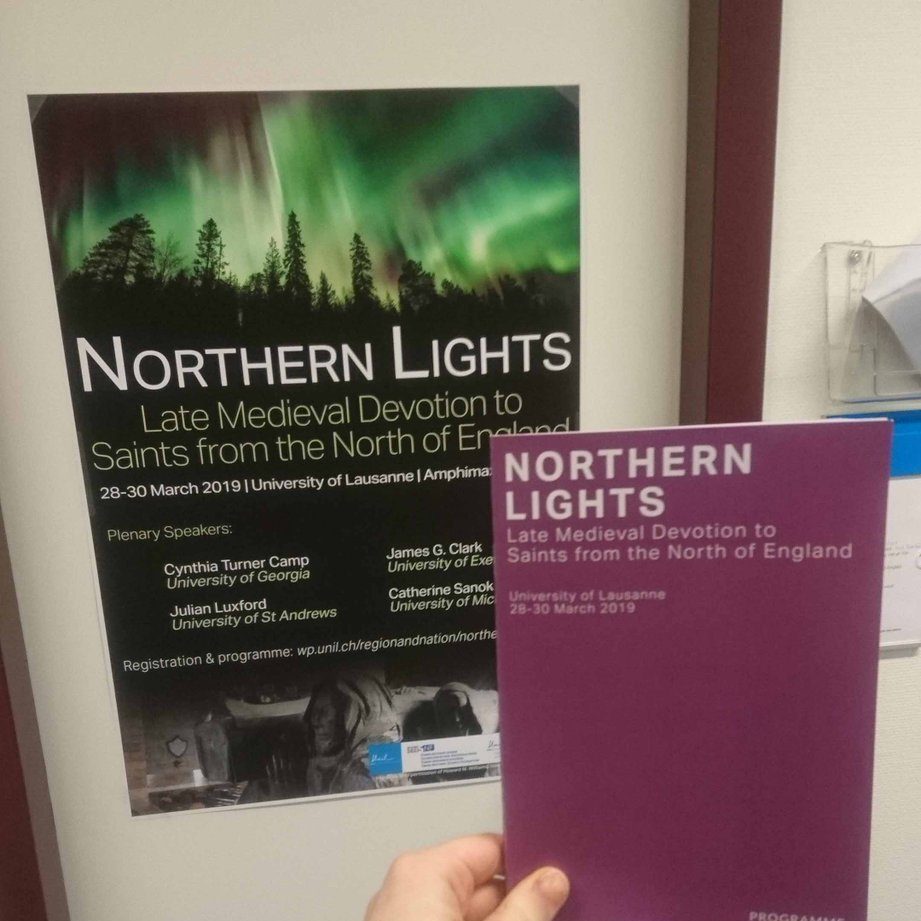Guest blogger and UNIL doctoral researcher Tino Oudesluijs discusses northern English language in the pre-modern period.
The north of England is not only known for its high number of celebrated Anglo-Saxon saints such as Cuthbert, Oswald, and Wilfrid of York – to whom devotional practices persisted in later medieval England – but also for its distinct language varieties compared to other parts of England throughout history. To this day, ‘northern’ speech in England is heavily marked, most notably due to the presence of various well-known distinct dialects and accents such as Geordie in Newcastle, Scouse in Liverpool, Mackem in Sunderland, and Mancunian in Manchester. This is much less the case for writing, however, seeing as everyone is nowadays schooled in using the standard variety (social media can a notable present-day exception to this).

Before the widespread diffusion and implementation of what would eventually become written Standard English (i.e. during the medieval and early modern period), however, northern English dialects comprised many differences from other varieties in writing as well, most notably on the levels of orthography, morphology, and syntax. Such differences attested in writing in turn give us some indication as to how people in the north of England spoke.
Moreover, when considering comments by various well-known writers on how people from the north sounded different from southerners, it becomes clear that people from the north of England have, throughout history, used the English language differently from those living elsewhere (most notably in the south). For example, Chaucer imitated northern speech for comedic effect in The Reeve’s Tale, and John of Trevisa, in his translation and ‘elaboration’ of Ranulph Higden of Chester’s Latin Polychronicon, wrote:
Alle the langages of the northumbres & specially at york is so sharp slitting frotyng & vnshappe/ that we sothern men may vnneth vnderstande that langage/ I suppose the cause be that they be nygh to the aliens that speke strangely/ And also by cause that the kyngis of englond abyde and duelle more in the south contrey than in ye north contre/ is by cause that ther is better corn londe more peple/ moo noble Citees/ & moo prouffytable hauenes in the south contrey than in the north.
William Caxton even consciously translated the Aeneid (Eynedos) into the local London-based variety of English, since “this booke is not for euery rude and vnconnynge man to see / but to clerkys and very gentylmen that vnderstande gentylnes and science.”
A bit of historical context

The reasons for many of the linguistic differences between the north and south of England throughout history predominantly lie in England’s complex social and political history, most notably in the contact with Old Norse during the time of the Danelaw (c. 865-950 AD). After Danish assaults on the East coast of Britain had started around 800 AD, the Scandinavian raiders started to settle more permanently around 865 in what is now most of east and north England. Over the course of the following decades, the Danish settlers had gained control over some of the largest kingdoms in Britain, including East Anglia and a large part of Northumbria (including York), leaving Wessex and Mercia as the most prominent Anglo-Saxon kingdoms, with whom various peace treaties were both brokered and broken in the decades following the 860s.
The arrival of the Scandinavians in the east and north of England had come after a time in which the north of Britain had flourished, both politically and culturally. After the Romans had left Britain in the 5th century AD, Irish monks such as St. Columba and St. Aidan travelled to the north of England and founded many monasteries, in this case the abbey of Iona in 563 AD and the monastery of Lindisfarne in 634 AD, respectively. This development not only established the north of England as an important religious centre in the early medieval period, it also meant that it became an important region for the production of written texts. The oldest surviving Old English text, Caedmon’s Hymn (most likely from between 658-680 AD), is indicative of this.
As such, in the Old English period the north provided England not only with poets such as Caedmon, but also with historians such as St. Bede (673-735 AD), and later also scholars such as Alcuin of York (735-804 AD). Moreover, Northumbria had become a powerful and independent kingdom during the 8th century. After the Danish raids and the establishment of the Danelaw area, however, the socio-political landscape in the north had changed dramatically, and after the descendants of King Alfred of Wessex defeated most of the Danish armies in the first half of the 10th century, Wessex had become the most powerful Anglo-Saxon kingdom.
Northern Middle English
Socio-historical events such as the arrival of the Scandinavian settlers had a considerable effect on the English/Scandinavian population living in most of the north of England, as the people living there were now descendants of both Anglo Saxon and Scandinavian people. As such, this also had a significant effect on the language. By 1300, northern Middle English had developed and changed rapidly in comparison to southern varieties, having for example reduced its inflectional and conjugational systems for nouns and verbs.

Many of the northern Middle English features visible in medieval manuscripts are nowadays no longer used, as throughout the history of the English language many distinct varieties across the country have slowly levelled their regional dialects, a process in which strictly local features are reduced and replaced by forms that had a wider regional currency. As such, typical northern English spellings such as kirk for ‘church’, bath for ‘both’, and quylk for ‘which’ are now no longer used, and the northern English inflection for the second person singular present tense, –es (thou comes), never diffused beyond the north, since elsewhere –est (thou comest) was preferred before the inflection was eventually dropped and replaced with a zero morpheme (you come).
Northern features in Standard English
There are however also some features of medieval northern English that ended up in the Standard English written variety and are thus still used to this day. Two of the most well-known examples of this are the third person singular present tense inflection –s (she comes), as opposed to –th (she cometh), and the use of they, their, and them as opposed to he, here, and hem. I must point out here that whereas the latter has traditionally been regarded as a clear example of Scandinavian influence on the English language, new research (most notably by Marcelle Cole) suggests that this development may have been native to English. This does not change the fact that the majority of attested th- spellings are indeed still from the north, but it does point out that not all variant features in the north have to be attributed to language contact with Old Norse alone.
Regardless, such developments of northern features ending up in the standard written variety have been attested for in written medieval texts. As such, they reflect written conventions, although these examples may also reflect how people would have spoken. Further changes in spoken English that have been accounted for in writing and that appear to have started in the north of England include the lengthening of vowels in open syllables, and the lowering of /e/ to /a/ (think of the way ‘Derbyshire’ is pronounced).

Over the past few decades, research into the development of written Standard English during the Middle English and Early Modern English periods has slowly shifted its focus from the south (predominantly London) to others regions of England as well, most notably in projects such as the The Middle English Scribal Texts Programme (MEST), a project based in Stavanger that comprises the Corpus of Middle English Local Documents (MELD) and the Middle English Grammar Corpus (MEG-C), and the Emerging Standards Project (EMST) in Utrecht and Lausanne, in which texts are considered from the largest urban centres after London in the period 1400-1700 (i.e. York, Bristol, Coventry, and Norwich).
As an increasing number of texts from all over England are being transcribed and made available, more is being discovered about Northern Middle English features and how they might have diffused to other parts of England (or not), and from this we can learn more on how and why people in the north of England spoke and wrote the way they did.
References and suggested further reading:
-
- Anderson, Peter, A Structural Atlas of the English Dialects (Routledge, 2015).
- Beal, Joan C., Lourdes Burbano-Elizondo & Carmen Llamas, Dialects of English. Urban North-Eastern English: Tyneside to Teesside (Edinburgh University Press 2012).
- Alexander & Laurel Brinton (eds.), English Historical Linguistics – An International Handbook (2 Vols.) (Mouton de Gruyter 2012).
- Cole, Marcelle, ‘A native origin for Present-Day English they, their, them’, Diachronica 35:2 (2018), pp. 165–209.
- Hickey, Raymond, The North of England and Northern English, in Hickey (ed.), Researching Northern English (John Benjamins 2015), pp. 1–24.
- Horobin, Simon & Jeremy Smith, An Introduction to Middle English (Oxford University Press, 2002).
- Jackson, Kenneth, Language and History in Early Britain (Edinburgh University Press 1953)
- McIntosh, Angus, M.L. Samuels & Michael Benskin, A Linguistic Atlas of Late Mediaeval English (Aberdeen University Press, 1986).
- Skeat, Walter William, English Dialects From the Eighth Century to the Present Day (Tredition GmbH, 2012).
- Smith, Jeremy, An Historical Study of English: Function, Form and Change (Routledge, 1996)
- The Cambridge History of the English Language (6 Vols.) (Cambridge University Press, 1992-2001).
- Wales, Katie, Northern English: A Social and Cultural History (Cambridge University Press 2006).
- Wright, Laura (ed.), The Development of Standard English, 1300-1800 (Cambridge University Press 2000).
Projects
- The Middle English Scribal Texts Programme: https://www.uis.no/research/history-languages-and-literature/the-mest-programme/the-middle-english-scribal-texts-programme
- Emerging Standards Project: http://www.emergingstandards.eu

